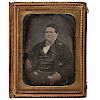Quarter Plate Daguerreotype of John A.P. Fisk, President of NYC "Fat Men's Club," by Knapp
About Seller
6270 Este Ave.
Cincinnati , OH 45232
United States
With offices in Cincinnati, Cleveland and Denver, Cowan’s holds over 40 auctions each year, with annual sales exceeding $16M. We reach buyers around the globe, and take pride in our reputation for integrity, customer service and great results. A full-service house, Cowan’s Auctions specializes in Am...Read more
Two ways to bid:
- Leave a max absentee bid and the platform will bid on your behalf up to your maximum bid during the live auction.
- Bid live during the auction and your bids will be submitted real-time to the auctioneer.
Bid Increments
| Price | Bid Increment |
|---|---|
| $0 | $25 |
| $500 | $50 |
| $1,000 | $100 |
| $2,000 | $250 |
| $5,000 | $500 |
| $10,000 | $1,000 |
| $20,000 | $2,500 |
| $50,000 | $5,000 |
| $100,000 | $10,000 |
About Auction
Nov 21, 2014 - Nov 22, 2014
Cowan's Auctions dawnie@cowans.com
- Lot Description
Quarter Plate Daguerreotype of John A.P. Fisk, President of NYC "Fat Men's Club," by Knapp
Quarter plate daguerreotype under a mat inscribed in red ink John A.P. Fisk Aged 15/ Weight 360 Pounds, housed in full, pressed paper case, interior velvet lining embossed Knapp/ Artist/ Alhambra/ 559/ Broadway.
John Anson Peckham Fisk (1836-1898) was a well-known New York City restaurateur and a member and president of the famed Fat Men's Club. An 1894 New York Times article reporting on the failure of his Broad Street restaurant after nearly 50 years in business states that "everybody in the down-town section knew Mr. Fisk," and describes his eatery as "especially elaborate." The article goes on to note that Fisk was a third-generation chop house keeper, and that his father and grandfather -- both men of "great avoirdupois" -- required that he reach the weight of 295 lbs. before entering the family business, which he did at age 13. Fisk was over 500 lbs at the time the article was written in 1894, and the Times notes his presidency of the Fat Men's Club as "a distinction his weight entitled him."
The Fat Men's Club was an East Coast gentleman's association which limited membership to men weighing at least 200 lbs. The club held an annual gala in New York to raise money for its annual clambake in Connecticut, and both were covered with perverse curiosity by dozens of publications, from Harper's Weekly to the New Zealand Star -- in fact the New York Times, in an 1891 article on the 25th annual celebration, titled "Fat Men at a Clambake," described them as "that affable assortment Brobdingnagian adiposity known wherever English newspapers are read."
An account of the 1869 gala, which includes a mention of Mr. Fisk serving as president, says that 150 to 200 members attended, and "as no member is permitted to weigh less than 200 pounds, the aggregate of humanity represented entitles it to be called the largest ball of the season." The writer gets even cheekier later on, commenting that although many of the wives of the members were thin, "there were enough heavyweights among the sex to vindicate the theory of women's rights and prove that women can compete with men, even in fatness, if they choose."
With only 23 members in attendance, as some had unsurprisingly died and "some got thin on a foreign diet," voiding their membership, the 1891 clambake required 25 bushels of clams, 100 chickens, 10 bushels of oysters, 500 ears of corn, a barrel-and-a-half of potatoes, a barrel of onions, 40 watermelons, and "other things in proportion." After the feast, some men actually held a footrace ("the contestants came in puffing like steam engines") and competed for the title of Most Graceful Dancer, while others attempted somersaults and did gymnastic exhibitions on the high bar.Solarization at mat edges. Plate with small scattered imperfection. Inscription on mat is slightly faded but still legible.Condition
- Shipping Info
-
SHIPPING. At the request of the buyer, Cowan's will authorize the shipment of purchased items. Shipments usually occur within two weeks after payment has been received. Shipment is generally made via UPS Ground service. Unless buyer gives special instructions, the shipping method shall be at the sole discretion of Cowan's Auctions, Inc.. Cowan's is in no way responsible for the acts or omissions of independent handlers, packers or shippers of purchased items or for any loss, damage or delay from the packing or shipping of any property.
-
- Buyer's Premium



 EUR
EUR CAD
CAD AUD
AUD GBP
GBP MXN
MXN HKD
HKD CNY
CNY MYR
MYR SEK
SEK SGD
SGD CHF
CHF THB
THB



